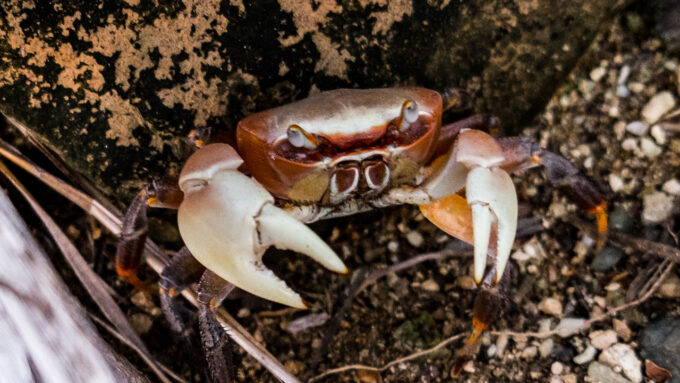Most terrestrial plants and animals left the ocean a single time in their evolutionary history to live ashore. But crabs have seemingly scuttled out of the sea more than a dozen times, with at least two groups later reverting back to a marine lifestyle, a study finds.
The research, published November 6 in Systematic Biology, sheds new light on the evolutionary history of the group Brachyura, which includes roughly 7,600 species of “true crabs,” and includes the most comprehensive evolutionary tree yet created for the group. And the study offers clues about how other early invertebrates may have evolved a terrestrial lifestyle, researchers say.
Unlike for well-studied animals such as birds and mammals, a unified crab tree of life has been lacking, says Kristin Hultgren, an invertebrate zoologist at Seattle University. “While the authors have developed a useful framework for understanding the complexity of transitioning to terrestrial life, one of the most important contributions is the extensive, well-dated evolutionary tree.”
Crabs are an extremely diverse group and have colonized nearly every type of habitat on Earth. It’s been a challenge to study when crabs first shifted from one habitat to another during evolution because, like some other invertebrates, crabs don’t have the extensive fossil trail that early vertebrates do, says Joanna Wolfe, an evolutionary biologist at Harvard University.
Past research has also often treated marine, freshwater and land crabs as discrete subgroups when they’re more like a continuum, Wolfe says. “They’re not distinct and actually have a lot in common, and looking at them together helps trace their evolution.”
Wolfe and her colleagues collected genetic data from 333 species of crabs in the group Brachyura. These crustaceans are evolutionarily distinct from, although closely related to, another group of crustaceans that independently evolved crablike bodies and are often erroneously referred to as crabs, including animals like the hermit and king crabs.
The team then combined that genetic data with dozens of fossils to generate a crab evolutionary tree, layering on details about each species’ life history and adaptations for living on land to reconstruct a possible timeline of when crabs colonized drier ground.
True crabs diverged from other crustacean lineages roughly 230 million years ago during the Triassic Period, the researchers found, refining previous estimates. Over the next hundred or so million years, brachyurans diversified widely during a period previously dubbed the “Cretaceous crab revolution.”
The study also showed that during their evolution, crabs appear to have adapted to a more terrestrial lifestyle as many as 17 times, either by shifting from the ocean to the intertidal zone or similarly salty habitats like mangroves, or by colonizing freshwater estuaries and rivers on route to land. In at least two cases, crabs reverted to a marine lifestyle long after they’d left.
The amount of times that crabs independently left the ocean is “astonishing,” says Katie Davis, an evolutionary paleobiologist at the University of York in England who was not involved in the research. “And it’s really fantastic that molecular biology, fossils and modern numerical techniques can be combined to provide insight into previously unanswerable questions.”
The study also hints at what other early arthropods that ventured onto the land may have been like, Wolfe says. Past studies have shown that crabs and insects share a common, if unknown, aquatic ancestor. By looking at the types of crabs that successfully left the ocean, it’s possible to guess at what adaptations early insects might have needed to do the same. Modern crabs living out of the water today, for example, excel at keeping themselves from drying out and have limited their dependence on water for reproduction.
“If you’re going to be the first proto-insect to come out of the ocean … you’re probably going to need those kinds of adaptations,” Wolfe says.






